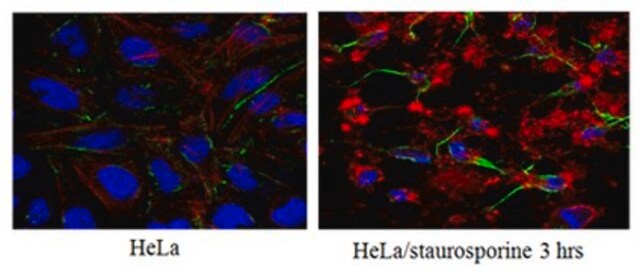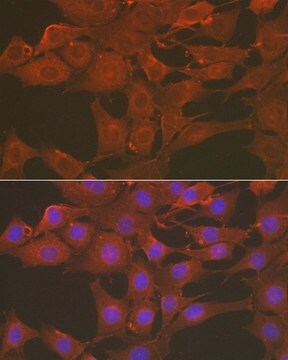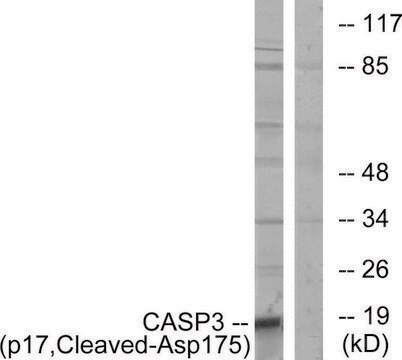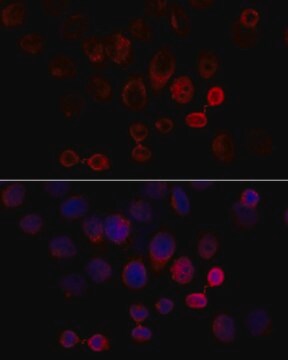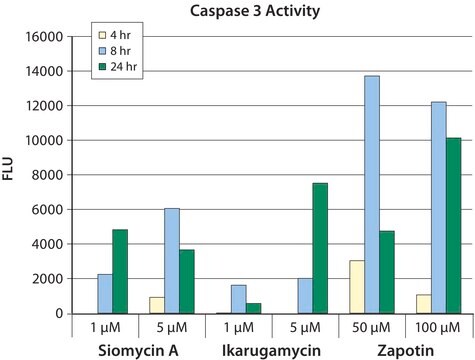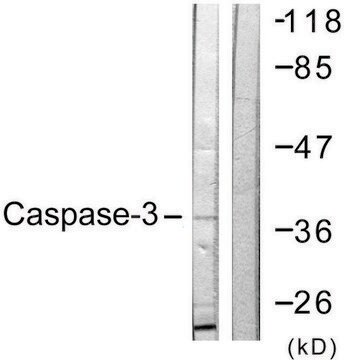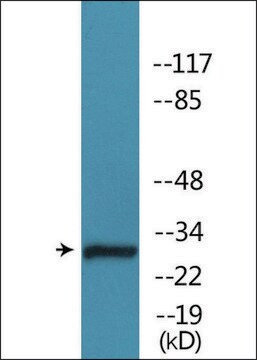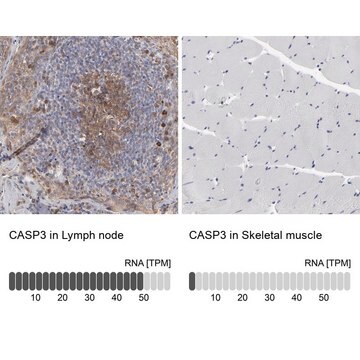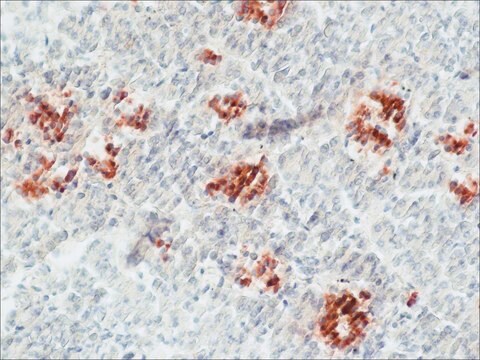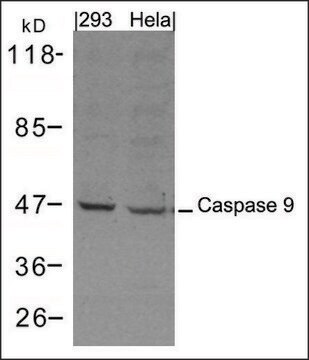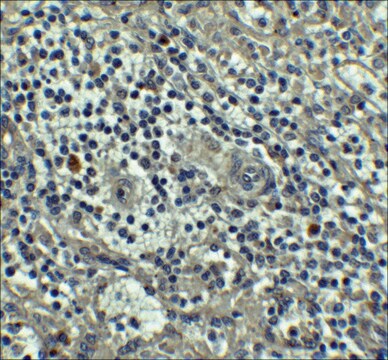C9598
Anti-Caspase 3 antibody produced in rabbit
IgG fraction of antiserum, buffered aqueous solution
Synonym(s):
Anti-Apopain, Anti-CPP32, Anti-Yama
Sign Into View Organizational & Contract Pricing
All Photos(1)
About This Item
Recommended Products
biological source
rabbit
Quality Level
conjugate
unconjugated
antibody form
IgG fraction of antiserum
antibody product type
primary antibodies
clone
polyclonal
form
buffered aqueous solution
mol wt
antigen 32 kDa
species reactivity
human
technique(s)
microarray: suitable
western blot: 1:3,000 using Jurkat human T-cell leukemia cell extract
UniProt accession no.
shipped in
dry ice
storage temp.
−20°C
target post-translational modification
unmodified
Gene Information
human ... CASP3(836)
General description
Caspase 3 is a cytosolic protein present as a 32 kDa proenzyme in cells. It is activated by proteolytic cleavage into the 20 kDa (p20) and 11 kDa (p11) active subunits when cells undergo apoptosis.
Immunogen
synthetic peptide corresponding to the N-terminal of human caspase 3 (amino acids 29-43 with C-terminally added lysine) conjugated to KLH. This sequence, unique to caspase 3, corresponds to N-terminal of the enzyme p20 subunit and is highly conserved in rat and mouse caspase 3.
Application
Anti-Caspase 3 antibody produced in rabbit is suitable for microarray and western blotting at a working dilution of 1:3000 using Jurkat human T-cell leukemia cell extract. It was used as a primary antibody for western blotting in a study to establish the biomolecular basis for the role of PCMT1 (isoaspartyl protein carboxyl-O-methyltransferase) as a part of a novel apoptosis regulatory mechanism. It was used to examine activation of caspase-3 via immunoblotting in a study to confirm the apoptosis of tumor cells mediated by AAV-ISN-T (recombinant adeno-associated virus vector with signal peptides of human insulin) administration. It was used as a primary antibody at 1:300 dilution for immunohistochemistry of deparaffinized sections of squamous cell carcinoma of the tongue containing surrounding normal tissue. It was used at a dilution of 1:1000 to detect caspase-3 and its cleaved form P20 in a study.
Biochem/physiol Actions
Caspase 3 cleaves many key proteins including poly(ADP-ribose) polymerase (PARP), sterol-regulatory element-binding proteins (SREBPs), DNA-dependent protein kinase (DNA-PK), α-fodrin, gelsolin, PKCd and DFF45/ICAD during apoptosis. High levels of this enzyme in lymphocytes suggest that it is an important mediator of apoptosis in the immune system. Deletion of CASP-3 gene in mice results in hyperplasia and cell abnormalities, indicating that caspase 3 is essential for morphogenetic cell death during normal brain development.
Caspase 3 is one of the key executioners of apoptosis downstream in the apoptotic pathway, as it is activated in cells by various death signals. In some neurodegenerative diseases, such as Huntington disease (HD) and Alzheimer′s disease (AD), specific neuronal caspase substrates have been identified. In Huntington disease (HD), caspase 3 specifically cleaves the HD gene product, Huntingtin.
Physical form
Solution in 0.01 M phosphate buffered saline, pH 7.4, containing 15 mM sodium azide.
Disclaimer
Unless otherwise stated in our catalog or other company documentation accompanying the product(s), our products are intended for research use only and are not to be used for any other purpose, which includes but is not limited to, unauthorized commercial uses, in vitro diagnostic uses, ex vivo or in vivo therapeutic uses or any type of consumption or application to humans or animals.
Not finding the right product?
Try our Product Selector Tool.
recommended
Product No.
Description
Pricing
Storage Class Code
10 - Combustible liquids
WGK
nwg
Flash Point(F)
Not applicable
Flash Point(C)
Not applicable
Choose from one of the most recent versions:
Already Own This Product?
Find documentation for the products that you have recently purchased in the Document Library.
Customers Also Viewed
Alterations in Gene Expression Associated with Head and Neck Squamous Cell Carcinoma Development.
Serewko-Auret, Magdalena M
Cancer, Genomics, and Proteomics, 1, 137-148 (2004)
Apoptosis: a review of programmed cell death.
Elmore S.
Toxicologic Pathology, 35(4), 495-516 (2007)
Huntingtin inhibits caspase-3 activation.
Zhang Y, et al.
The Embo Journal, 25(24), 5896-5906 (2006)
Q Song et al.
The EMBO journal, 15(13), 3238-3246 (1996-07-01)
Radiosensitive cell lines derived from X-ray cross complementing group 5 (XRCC5), SCID mice and a human glioma cell line lack components of the DNA-dependent protein kinase, DNA-PK, suggesting that DNA-PK plays an important role in DNA double-strand break repair. Another
Hong Ma et al.
Hepatology (Baltimore, Md.), 42(6), 1355-1363 (2005-12-01)
The extracellular domain of the tumor necrosis factor-related apoptosis-inducing ligand (sTRAIL) may function as a soluble cytokine to selectively kill various cancer cells without toxicity to most normal cells. We constructed a series of recombinant adeno-associated virus (AAV) vectors expressing
Our team of scientists has experience in all areas of research including Life Science, Material Science, Chemical Synthesis, Chromatography, Analytical and many others.
Contact Technical Service

